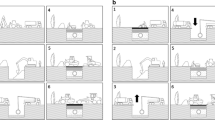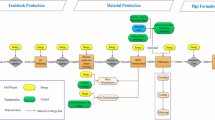Abstract
The demand for sanitation infrastructures is increasing due to a rise in the urban population. To meet the need for wastewater collection, the construction of sewer networks must comply with a series of technical parameters that indicate whether a solution is feasible or not. Considering that this construction implies a series of environmental impacts, this study coupled a structural analysis of one linear metre of sewer constructive solutions with their life cycle impacts. Different pipe materials (concrete, polyvinylchloride (PVC) and high-density polyethylene (HDPE)) were combined with different trench designs and their environmental performance was assessed using Life Cycle Assessment (LCA). These solutions complied with technical parameters consisting of traffic loads and pavement conditions, among others. Concrete pipes embedded in granular matter result in fewer environmental impacts, such as Global Warming Potential or Cumulative Energy Demand. Further, re-using the excavated soil results in up to 80 % of environmental savings with respect to extracting new materials. Concerning traffic loads and pavement conditions, failures in plastic pipes could be avoided if these are embedded in concrete. Moreover, the environmental impacts of this solution are similar to those resulting from the substitution of pipes that do not comply with the mechanical requirements of the construction site. Therefore, proper planning is needed to provide cities with sewers that are resilient to time and external loads and reduce the urban environmental impacts.




Similar content being viewed by others
References
Anders K, Anders A (1997) Environmental assessment of sewage pipes in PVC, PE, PP and concrete (Miljøvurdering af afløbsrør i PVC, PE, PP og beton). DOR/Nordiska Plaströrgruppen, Stock
ASTM Standard C118 (2011) Standard Specification for Concrete Pipe for Irrigation or Drainage. doi:10.1520/C0118-11, www.astm.org
ASTM Standard D2321 (2014) Standard Practice for Underground Installation of Thermoplastic Pipe for Sewers and Other Gravity-Flow Applications. doi:10.1520/D2321-14, www.astm.org
Bizier P (2007) Gravity sanitary sewer design and construction, ASCE 2nd E. ASCE Publications, ASCE Publications
Blanco A, Pujadas P, Cavalaro SHP, Aguado A (2014) Methodology for the design of controlled low-strength materials. Application to the backfill of narrow trenches. Constr Build Mater 72:23–30. doi:10.1016/j.conbuildmat.2014.09.008
Bobylev N (2011) Comparative analysis of environmental impacts of selected underground construction technologies using the analytic network process. Autom Constr 20:1030–1040. doi:10.1016/j.autcon.2011.04.004
Bottero M, Peila D (2005) The use of the analytic hierarchy process for the comparison between microtunnelling and trench excavation. Tunn Undergr Sp Technol 20:501–513. doi:10.1016/j.tust.2005.03.004
CPSA. Concrete Pipeline Systems Association (2010) PAS 2050- partial lifecycle assessment. Cradle-to-gate analysis for concrete pipeline. Manhole Ring and Cover Slab
da Silva JL, El Debs MK, Beck AT (2008) Reliability evaluation of reinforced concrete pipes in crack opening limit state. RIEM 1:314–330
Davies J, Clarke B, Whiter J et al (2001) The structural condition of rigid sewer pipes: a statistical investigation. Urban Water 3:277–286. doi:10.1016/S1462-0758(01)00036-X
de la Fuente A, Escariz RC, de Figueiredo AD, Molins C, Aguado A (2012) A new design method for steel fibre reinforced concrete pipes. Constr Build Mater 30:547–555. doi:10.1016/j.conbuildmat.2011.12.015
De La Fuente A, Escariz RC, De Figueiredo AD, Aguado A (2013) Design of macro-synthetic fibre reinforced concrete pipes. Constr Build Mater 43:523–532. doi:10.1016/j.conbuildmat.2013.02.036
EN 1401-1:2009 Plastic piping systems for non-pressure underground drainage and sewerage. Unplasticized poly(vinyl chloride) (PVC-U). Specifications for pipes, fittings and the system. British Standards Institution
EN 1916:2002 Concrete pipes and fitting, unreinforced, steel fibre and reinforced. AENOR, Madrid
Guinée JB, Gorrée M, Heijungs R, Huppes G, Kleijn R, Koning A de, Oers L van, Wegener Sleeswijk A, Suh S, Udo de Haes HA, Bruijn H de, Duin R van HM (2002) Handbook on life cycle assessment. Operational guide to the ISO standards. I: LCA in perspective. IIa: Guide. IIb: Operational annex. III: Scientific background. Kluwer Academic Publishers, ISBN 1-4020-0228-9, Dordrecht, 692 pp.
Haghighi A, Bakhshipour AE (2012) Optimization of sewer networks using an adaptive genetic algorithm. Water Resour Manag 26:3441–3456. doi:10.1007/s11269-012-0084-3
Hischier R, Weidema B, Althaus H et al (2010) Implementation of life cycle impact assessment methods. Final report ecoinvent v2.2 No. 3. Swiss Centre for Life Cycle Inventories, Dübendorf
Hodges SH, Enyart JI (1993) Standard installation. International Conference on Pipeline Infrastructure, Texas
INTRON (1995) Environmental profile and environmental measures of a concrete external sewer [Intron report No. 95027] and Environmental profile and environmental measures of an external sewer of PVC and vitrified clay in comparison to concrete [Intron report No. 95195]. INTRON, Netherlands
ISO (2006) ISO 14040: 2006 Environmental management - Life cycle assessment - Principles and framework
Jin NJ, Hwang HG, Yeon JH (2013) Structural analysis and optimum design of GRP pipes based on properties of materials. Constr Build Mater 38:316–326. doi:10.1016/j.conbuildmat.2012.07.115
Marston A (1930) The theory of external loads on closed conduits in the light of the latest experiments. Bulletin 96. Iowa Engineering Experiments Station, Ames
McGrath TJ, Chambers RE, Sharff PA (1990) Recent trends in installation standards for plastic pipe. Buried plastic pipe technology. ASTM STP 1093:281–293
Mendoza J-M, Oliver-Solà J, Gabarrell X, Rieradevall J, Josa A (2012) Planning strategies for promoting environmentally suitable pedestrian pavements in cities. Transp Res Part D: Transp Environ 17:442–450. doi:10.1016/j.trd.2012.05.008
MetaBase ITeC (2010) Online ITeC database: prices, technical details, companies, certificates, product pictures and environmental data. http://www.itec.cat/metabase. Accessed Feb 2013
Moser AP (2001) Buried plastic pipe technology, issue 1093. ASTM International
Petit-Boix A, Sanjuan-Delmás D, Gasol C et al (2014) Environmental assessment of sewer construction in small to medium sized cities using life cycle assessment. Water Resour Manag 28:979–997. doi:10.1007/s11269-014-0528-z
Petit-Boix A, Sanjuan-Delmás D, Chenel S et al (2015) Assessing the energetic and environmental impacts of the operation and maintenance of Spanish sewer networks from a life-cycle perspective. Water Resour Manag 29:2581–2597. doi:10.1007/s11269-015-0958-2
Peyvandi A, Soroushian P, Jahangirnejad S (2014) Structural design methodologies for concrete pipes with steel and synthetic fiber reinforcement. ACI Struct J 111:83–91
PRé Consultants (2010) SimaPro 7.2.0. PRé Consultants, Amersfoort
Pujadas P, Blanco A, Cavalaro S, Aguado A (2015) Performance-based procedure for the definition of controlled Low-strength mixtures. J Mater Civ Eng 27:06015003. doi:10.1061/(ASCE)MT.1943-5533.0001283
Sanjuan-Delmás D, Petit-Boix A, Gasol C et al (2014) Environmental assessment of different pipelines for drinking water transport and distribution network in small to medium cities: a case from Betanzos, Spain. J Clean Prod 66:588–598. doi:10.1016/j.jclepro.2013.10.055
Spangler MG (1941) The structural design of flexible pipe culverts. Bull. 153. Eng. Exp. Stn, Ames
Swamee PK, Sharma AK (2013) Optimal design of a sewer line using linear programming. Appl Math Model 37:4430–4439. doi:10.1016/j.apm.2012.09.041
Swiss Centre for Life Cycle Inventories (2009) ecoinvent database v3.0. Technical report
The World Bank (2014) Urban population (% of total). http://data.worldbank.org/indicator/SP.URB.TOTL.IN.ZS. Accessed Jul 2014
Twort AC, Ratnayaka DD, Brandt MJ (2000) Water supply. Butterworth-Heinemann
U.S. Army Corps of Engineers (1998) Engineering and design. Conduits, culverts, and pipes. Engineer Manual 1110-2-2902. Washington, 20314-1000
UN. United Nations. Department of economic and social affairs. Population division (2012) World Urbanization Prospects: The 2011 Revision, CD-ROM Edition
UNE 53331:1997 Plastics. Unplastized poly(vinyl chloride) and high and medium density polyethylene (PE) pipes. Criterion for the assessment of pipes for plastics piping systems with car without pressure under external loads. AENOR, Madrid
Valderrama C, Granados R, Cortina JL, Gasol CM, Josa A (2013) Comparative LCA of sewage sludge valorisation as both fuel and raw material substitute in clinker production. J Clean Prod 51:205–213. doi:10.1016/j.jclepro.2013.01.026
Venkatesh G, Hammervold J, Brattebø H (2009) Combined MFA-LCA for Analysis of Wastewater Pipeline Networks. J Ind Ecol 13:532–550. doi:10.1111/j.1530-9290.2009.00143.x
Viñolas B (2011) Applications and methodology advances in MIVES multicriteria valorations (Aplicaciones y avances de la metodología MIVES en valoraciones multicriterio). Doctoral Thesis. Universitat Politècnica de Catalunya
Acknowledgments
The authors would like to thank the Spanish Ministry of Education for the grant awarded to A. Petit-Boix (FPU13/01273) to conduct this research.
Author information
Authors and Affiliations
Corresponding author
Electronic supplementary material
Below is the link to the electronic supplementary material.
ESM 1
(PDF 534 kb)
Rights and permissions
About this article
Cite this article
Petit-Boix, A., Roigé, N., de la Fuente, A. et al. Integrated Structural Analysis and Life Cycle Assessment of Equivalent Trench-Pipe Systems for Sewerage. Water Resour Manage 30, 1117–1130 (2016). https://doi.org/10.1007/s11269-015-1214-5
Received:
Accepted:
Published:
Issue Date:
DOI: https://doi.org/10.1007/s11269-015-1214-5




